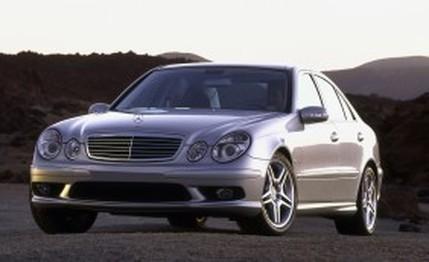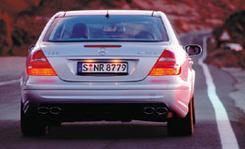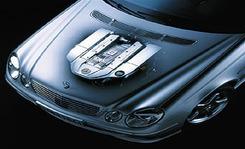
 First Drive Review
First Drive Review
Hard to believe, but no longer is a mere 349 horsepower de rigueur for a Mercedes E55 AMG. The company has decided nothing less than the supercharged V-8 of the ridiculously powerful SL55 AMG will do the job of intimidating the Teutonic heavy-metal opposition.
Just five years ago, about 350 horses established you as a credible tarmac-burning player. The BMW M5 raised the bar to 394, only to be recently overtaken by the twin-turbo Audi RS 6 with 450. Now it's Mercedes' turn to scorch the rankings.
This most powerful E55 AMG ever, due in the U.S. in May, gets 34 percent more power and an extra 32 percent of pound-feet over the old, naturally aspirated, once seriously fast E55. It's enough grunt to qualify this E55 as the quickest production sedan in the world. We estimate it will rip to 60 mph in 4.5 seconds, 0.1 second ahead of Audi's claim for the RS 6 and 0.2 second quicker than the M5. And the rate of forward motion doesn't slacken as the estimated 10.5 seconds to 100 mph suggests. All this with an automatic transmission, although you can shift gears manually using buttons behind the steering wheel. And get this: Assisted by an IHI belt-driven screw supercharger that spins at 23,000 rpm to a maximum pressure of 11.6 psi, the 5.4-liter V-8 produces a monstrous 516 pound-feet of torque from 2650 to 4500 rpm.


A word of explanation is needed here. The V-8 in the E55 is not exactly the same as the one in the SL55 AMG. Expect to be confused. At its launch, the SL55 produced the same figures as the E55. Then AMG found that 469 horsepower was at the very low end of the engine's tolerances. So it had the V-8 that's in the SL55 recertified at 493 horsepower. Now AMG admits that, due to differences in the induction geometry between the SL55 and E55 and the E55's longer exhaust system, the E55 produces less horsepower. That longer exhaust system may account for the more subdued, less dominant, but still potent exhaust waffle that's close to perfect for the sedan. Neither of which, apparently, makes any difference to the torque output. The E55 does have a slightly taller final-drive ratio than the SL55 (2.65 versus 2.82 for the sports car), but since the E55 weighs about 500 pounds less, we think it will be the quicker of the two.


Behind the wheel, it's impossible not to play rally driver with this car. At least some of the time. Shift time is 35 percent quicker than a regular Mercedes automatic, and roughness increases by a similar amount. But because the tranny is adaptive, it quickly learns when the driver has backed off and then seemingly skims through the gears. You choose between sport and comfort modes (the latter replaces the old winter setting to provide second-gear starts).
It rained hard all day during our first outing in the E55. In the old 500E—Mercedes' first supersedan—our day would have been punctuated by slipping and sliding. Yet driven fairly hard (as our 11-mpg average attests), the rear-drive E55 rarely stepped out of line, only the occasional flashing of the high-threshold electronic-stability-program warning light indicating a break in adhesion. Switch off the ESP, and you can light up the tires at will, and power oversteer becomes the norm. Yet the big heavy E55 remains remarkably controllable and agile and is still capable of generating plenty of understeer-biased cornering forces on wet roads, even if it lacks the massive security of the RS 6. Its quick (2.75 turns lock-to-lock) speed-sensitive steering has more feel and fluency and is beautifully weighted. Mercedes' air suspension also endows a far better—even cosseting—ride than the Audi, provided you ignore the hardest of the three damper-and-spring settings, which relays every small bump and irregularity in the road. Stability is impressive, at least up to 125 mph, and we can tell you that the rain management of the body and wipers is terrific. The brakes, from the SL55 AMG, are electrohydraulic, as in all new E-class cars, and immensely powerful, but they require a sensitive touch for smooth modulation as the car comes to a halt.
The E55 interior is superbly equipped, spacious, and comfortable (apart from the ridiculously short receiving end of the seatbelts) if not quite as exquisitely built as an RS 6.
It's another super-refined, super-subtle, supersedan from AMG. Except maybe this time the lack of visual distinctiveness is too discreet. There are the AMG three-section air inlets in the lower bumper, 18-inch alloys wearing suitably broad 245/40 and 265/35 rubber, and four oval chrome exhaust pipes. But the body would benefit from more macho massaging, especially for a car that will cost about $75,000.
It's inevitable that one day there will be quicker sedans than the E55 AMG. But we can wonder if any will possess the same balance of refinement, poise, and performance that makes the E55 so brilliantly complete.